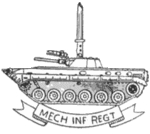Mechanised Infantry Regiment
The Mechanised Infantry Regiment is an infantry regiment of the Indian Army, comprising 27 battalions dispersed under various armoured formations throughout India. It is one of the youngest regiments in the army, and though it was formed as a result of lessons learned in the 1965 Indo-Pak War, to give infantry battalions greater mobility, it was the mastermind of late Gen K Sundarji who had the foresight to cater the needs of a modern army.[1] Initially, some of the older infantry battalions of various regiments were equipped with the BMP-1 armoured personnel carriers. The need for something more concrete and viable was felt along with a need to develop a common philosophy with regards to the type of tactics. This necessitated the raising a totally new arm in the Indian Army, resulting in the various mechanised battalions being brought together under a single cap badge as the Mechanised Infantry Regiment in 1979.[1]
| Mechanised Infantry Regiment | |
|---|---|
 Regimental Insignia of the Mechanised Infantry Regiment | |
| Active | 1979 - Present |
| Country | |
| Branch | |
| Type | Line Infantry |
| Role | Mechanised Infantry |
| Size | 27 Battalions |
| Regimental Centre | Ahmednagar, Maharashtra |
| Motto(s) | Valour & Faith |
| War Cry | Bolo Bharat Mata Ki Jai (Victory to Mother India) |
| Insignia | |
| Regimental Insignia | A rifle bayonet mounted on a BMP-1, depicting the infantry and mechanised facets of the Regiment |
The Mechanised Infantry Regiment has participated in Operation Pawan in Sri Lanka, Operation Rakshak in Punjab and Jammu & Kashmir and Operation Vijay in Jammu & Kashmir. It also specialises in UN Peacekeeping Operations in Somalia, Congo, Angola and Sierra Leone. The Regiment has its affiliation to INS Gharial of the Indian Navy. The Mechanised Infantry Regiment of the Indian Army has a special distinction of operating even in the high altitude areas of Ladakh and Sikkim.[1]
Gen Sundarji was appointed the first Colonel of the Mechanized Infantry Regiment, the post he held till his retirement.
MIRC Institutions
Quarter Guard
The Quarter Guard of the MIRC was created on 9 August 1979 during the first biennial conference. After the sanction of KLP, the present Quarter Guard was conceptualised in half circular area with front wide platform. The new Quarter Guard was completed in 1986. The Quarter Guard has 18 internal rooms as well as an armour shop and a guard room. At the to the right and left side of the guard are two guns and two cannons the symbolise the strength of soldiers.[2]
Military Band
The MIRC Band is based at Ahmednagar and serves all regimental duties related to musical support. The band was formed during April 1982 under the auspices of Brigadie Tilak Raj. The band has held the honour of performing at national events such as the Beating Retreat, Army and Republic Day Parades, as well as events at the Rashtrapati Bhavan. It also has performed at the 2007 Military World Games, the 2010 Commonwealth Games, and the 2001 Mumbai International Fleet Review among others.[2]
Regimental museum
The MIRC Museum was founded and inaugurated on 9 February 2000 by Lieutenant General Pankaj Joshi, the then Colonel of the regiment. The museum is currently housed at ground floor of Mechanised Bhavan. The museum houses the regimental colour, as well as the history if the MIRC and mementos from Colonels of the regiment.[2]
Equipment
- BMP-1 Infantry Fighting Vehicles
- BMP-2 Infantry Fighting Vehicles
- BTR-60 and BTR-70 Armoured Personnel Carriers
- TATA Kestrel
Battalions converted to Mechanised Infantry Regiment
- 1st Battalion (former 1st battalion Madras Regiment)
- 2nd Battalion (former 1st battalion Jat Regiment)
- 3rd Battalion (former 1st battalion 8 Gorkha Rifles)
- 4th Battalion (former 1st battalion Sikh Regiment)
- 5th Battalion (former 14th battalion Kumaon Regiment)
- 6th Battalion (former 1st battalion Garhwal Rifles)
- 7th Battalion (former 1st battalion Dogra Regiment
- 8th Battalion (former 7th battalion Punjab Regiment)
- 9th Battalion (former 7th battalion The Grenadiers)
- 10th Battalion (former 20th battalion Maratha Light Infantry)
- 11th Battalion (former 18th battalion Rajputana Rifles)
- 12th Battalion (former 16th battalion Mahar Regiment, earlier 8th battalion Parachute Regiment)
- 13th Battalion (former 18th battalion Rajput Regiment)
- 14th Battalion (former 16th battalion Jammu & Kashmir Rifles)
- 15th Battalion
- 16th Battalion
- 17th Battalion (Reconnaissance and Support) (Tracked)
- 18th Battalion
- 19th Battalion (Reconnaissance and Support) (Tracked)
- 20th Battalion
- 21st Battalion
- 22nd Battalion
- 23rd Battalion (Reconnaissance and Support) (Wheeled)
- 24th Battalion (former 20th battalion Rajput Regiment)[1]
- 25th Battalion (Reconnaissance and Support) (Wheeled)
- 26th Battalion
- 27th Battalion - Bhusaval, Maharashtra[3]
External Media
- Indian Army Mechanised Infantry describing the weapons, vehicle and soldiers
- images of the Mechanised Infantry showing the combat vehicles.
References
- Bharat Rakshak :: Land Forces Site - The Mechanised Infantry Regiment Archived 2012-01-26 at the Wayback Machine
- https://salute.co.in/raising-of-the-mechanised-infantry-regimental-centre/
- "27th Mechanised Infantry Battalion: New chapter added to Indian Army". The Indian Express. 2017-07-23. Retrieved 2017-07-23.
